Summer SAVY 2022/Session 5 – Mythology for Rising 1st/2nd Grade
Posted by caughem on Monday, July 18, 2022 in blog, SAVY.
Friday: Just like the Olympian gods and goddesses (ancient and modern) we have studied, we have finished well today! We have learned that the ancient Olympic games were training activities and competitions for improving warriors by developing quieted minds and endurance for completing the race and overcoming the challenges (even the painful ones). What were the qualities of the first athletes? How were and are they similar to the mythological gods? Are the games different or similar today? Who is the best or most powerful or fastest? What are the habits or characteristics of a famous athlete such as Eliud Kipchoge? What can we learn from his story?
Today’s lessons also included the myths (and misadventures) of King Midas of Greek legend and lore. Additionally, we took another hard look at the ancient Greek geography, climate, and natural wonders. With so many interesting features such as gorges, mountains, rivers, and dangerous ocean seas it’s easy to understand that they thought the gods could be displaying their wrath! We’ll not soon forget the sight of natural methane vents that rupture and catch fire! They almost invoke a desperate plea for a rescuer from what does look like the very gates of Hades! Exciting stuff!
However, the excitement of the day continued as we shared our final presentations with one another. Our Measures of a Myth project allowed us to synthesize our learning into an original mythological story of our own making. How did our stories measure up? Did they have references or direct evidence of a certain culture? What strengths and weaknesses did the main god/goddess have? What did our story stive to teach us and how? Some of us wrote our stories and others used a storyboard format. Still others chose a combination approach. How will we look for these lessons and those of the traditional myths in our modern culture? What new lessons do we still have to learn from these power stories and will we continue to tell them in the future?
Thank you for making this opportunity available to your child. I’m grateful for the journey of thousands of miles and as many years that we have traversed together this week!

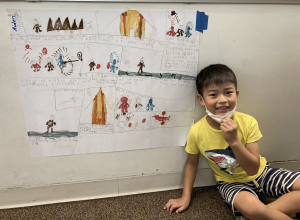
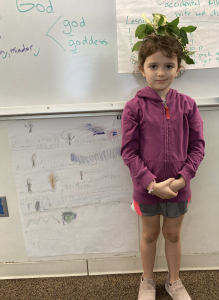
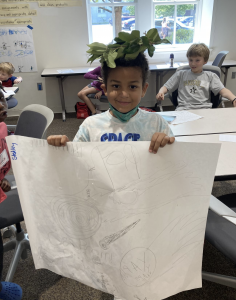

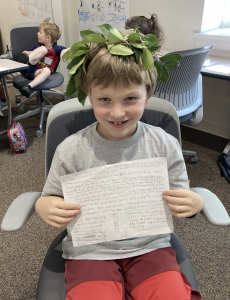
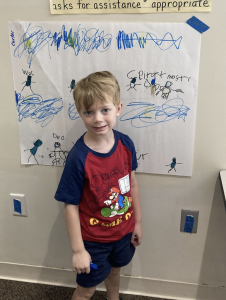

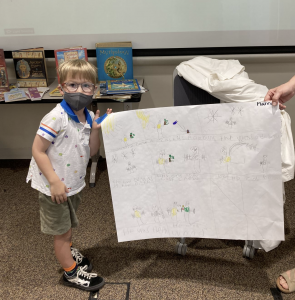
Thursday: Menacing Monsters (and the monsters within ourselves) and the Heros that overcome them were a big hit today! We started the day with a reading of a beloved modern text, Where the Wild Things Are, by Maurice Sendak. We looked for evidence of mythological influences (a journey, positive and negative character traits, change, and of course monsters) in this story. Throughout the day we dove deep into the monster and abstract concept of a hydra (a really complexed problem that requires multiple solutions, collaborations, and perseverance to overcome), The Minotaur, The Gorgon named Medusa, and many, many more. We have gained such a knowledge of the different characters that we are making connections continuously to other stories and concepts. What fun!
There have been many small work sessions today for our final projects to be presented tomorrow. What is the culture or historical significance of my story? What are the strengths and weaknesses of my featured god/goddess? Is this story autobiographical? What does lesson can be drawn from this story? Is there symbolism in an item or character? The students are really engaged and excited to make all these connections to their learning! What questions are we generating for future learning?
We are close to meeting all the goals of our course!
-
To identify and understand the influences of mythology in modern culture in relation to science, architecture, and social values. Over and over again.
-
To create and develop a mythological character and story line with drawings and/or narratives. We’re working on it and will complete on schedule!! 🙂
What a great final day we have in store! More gods and goddesses, more stories, more connections to our cultures today! We can’t wait!
Wednesday: What a wonder filled Wednesday! We began the day by sitting outside near one of our beautiful Peabody Campus buildings, Wyatt, and identified the architectural elements we had studied the previous day. The students sketched what they observed and labeled the elements with their new acquired vocabulary. Why do some buildings have so many elements of ancient Greek incorporated into their design? What values are these elements symbolics of? Strength? Balance and symmetry? Students worked toward accuracy and detail in their drawings. What connections can we make to other building in our culture?
If ancient Greeks pioneered advances in politics, science, arts, and philosophy what influences did the Romans borrow from Greek mythology and culture when they conquered Greece? What connections can we observe between similar mythological characters such as Jupiter and Zeus or Neptune and Poseidon? What about Heracles and Hercules? What does our society borrow in the symbols we use in buildings at our nation’s Captial? We took a look at many building designs and even some of the sculptures in pediments. What values do we borrow from Greek and Roman mythology that go with democracy such as freedom, war, peace, justice, etc.?
Finally, we continued to study and research different gods and goddesses in preparation for our own project presentation on Friday. Students are now developing or creating their own gods/goddesses that relate to a certain culture we have studied. They are identifying relatives, personal strengths and weaknesses and other characteristics of the fictious characters. What tools or symbols can be a part of the story? They will be using story boards to tell a new story in a mythological style to their friends. What will be their reason for telling this story? How did Mrs. Byrd become the goddess of pencils? 🙂
Hang on! Tomorrow, we take on the monsters! Medusa, a minotaur, hydras, and much more!
Tuesday: Another amazing day! We read about Persephone and her misadventures in the underworld with Hades and the faithfulness of Demeter, her mother. What was the purpose of retelling this myth in the Greek culture? Was it to explain unknown scientific phenomenon? Was it to teach character lessons? Both? This took us to discussions about our present knowledge of how our solar system works and the implications for seasonal changes. It also brought about more philosophical ideas. The body of Truth and the head of Falsehood – Wow! This phrase from an African-Cuban creation story during our learning on Monday was repeated often by students today in review other mythological stories. It must have made an impact on our collective thinking.
They began independent research on their chosen god or goddess using a variety of class texts and resources. This was very challenging and also a great opportunity for students to persevere with a difficult task. Students have choice in the ways they can record their new knowledge and understanding. This is preparing us for our final project presentation to be discussed tomorrow for Friday.
We continue to ask why is mythology so powerful in our culture today and we are documenting evidence of influences, especially from Greek and Roman cultures. Tomorrow was will take a quick walk to sketch buildings where we anticipate seeing pediment facades, unifying porticos, arches, and columns (Doric, Ionic, and maybe an elusive Corinthian example). We’ll be looking for those flutes to determine either the Roman or Greek influences. Looking forward to another epic day!
Monday: Our class had a tremendous start today and the students were so eager to share what they already know about Mythology and what they want to learn. At the end of the day, we celebrated all that we have learned on Day1! We used a KWL Chart format all day which includes recording three columns of information: K-What we think we Know, W-What we Want to know, and L-What we have Learned. We filled up 3 posters with information!
Why do ancient civilizations the world over construct mythology (tell stories) and what information do they pass on in these early stories? We made two observations and have more ideas that we are researching: 1) To explain unknown scientific phenomenon (not known in ancient cultures at that time) and 2) To observe good/bad behaviors in people (or gods) in order to instruct concerning desired and undesired character qualities (greed, truth, etc.). We observed and discussed creation stories from multiple civilizations including Native American, Aztec, Hindu, Norse, Egyptian, African, and of course Greek. We wondered what other cultures we should still consider in the days to come. What similarities and differences are there in the elements of the stories? What connections can we make between the geographical regions and the stories?
In case your child wants to establish a new rule at home this evening, here is the “class rule” that we are using successfully this week. It actually works great anywhere or anytime, but it requires thinking and reasoning. 🙂. You can do almost anything you want in this class, as long as it doesn’t cause a problem for yourself or others. These students are definitely problem solvers! I look forward to our learning adventures this week!








